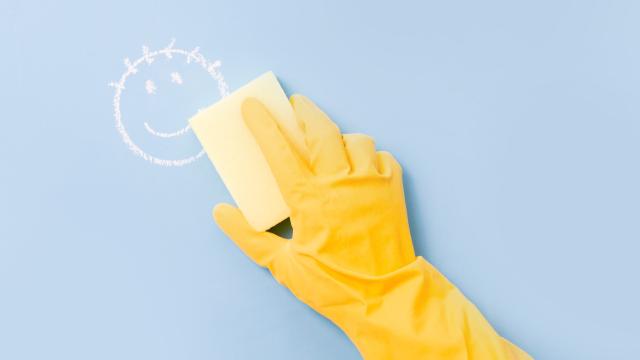Magic erasers are incredibly versatile cleaning products, capable of removing even the stubbornest stains and hardened gunk from a variety of surfaces. But sometimes, they work a little too well, taking off a little bit of paint or varnish along with the gunk. This is because magic erasers are abrasive cleaners that aren’t marketed as such. To avoid disaster, you need to keep this in mind.
Even though they look like sponges, magic erasers are actually blocks of melamine foam, a porous material that’s way less cuddly than it sounds. According to HowStuffWorks.com, melamine foam is made of microscopic air bubbles encased by threads of hardened melamine resin. These threads are very hard when intact and very sharp when broken, like tiny shards of glass. Rubbing a magic eraser on a surface puts its powerful combination of features to work: The melamine resin scrapes stuff up, and the air bubbles instantly absorb it. If there’s anything left over, a little extra pressure breaks the melamine down into tiny particles, which add even more abrasive power. It’s like using sandpaper that vacuums up its own dust.
Once you understand how magic erasers work, figuring out when not to use one gets much easier. If you would never, ever use sandpaper on a given surface — not even the finest possible grit — don’t use a magic eraser on it, either. This eliminates most painted, enamelled, varnished, sealed, or otherwise coated surfaces, which you may recognise as the most common victims of magic eraser-related crimes. Stainless steel also falls into this category, as magic erasers can permanently dull its smooth finish. Basically, if there’s a shiny coating involved, keep the magic eraser far away.
You should also remember that, like sandpaper, magic erasers don’t work without a little elbow grease. For example, if you were to cut up a magic eraser and chuck the pieces in your toilet — a real thing that I’ve seen recommended for some reason — it will not somehow magically “scrub” the bowl clean when you flush. The air bubble-melamine combo needs to physically rub up against something in order to scour it off and absorb the evidence; dissolving it in water defeats the purpose. You’re better off using WD-40, Alka-Seltzer, or even mouthwash, all of which will actually dissolve grime.
Other than that, most surfaces are fair game for a magic eraser. It’s always a good idea to test a small patch out of eyesight first, especially for surfaces you’ve never used a magic eraser on before. But really, as long as you avoid shiny stuff — and remember that even “magic” cleaning products have to obey the laws of physics — you should be fine.

Leave a Reply
You must be logged in to post a comment.